Last Chance to Catch NYC's Holiday Notalgia Train
We met the voices of the NYC subway on our nostalgia ride this weekend!


Have you heard of the West Side Tennis Club? The millions of fans that watched the U.S. Open finals this past weekend saw an unusual scene at Flushing Meadows-Corona Park — empty stadiums due to the coronavirus pandemic. But only some would have known that the U.S. Open wasn’t always played in Flushing. In fact, for 62 years, the U.S. Open was hosted at the West Side Tennis Club in Forest Hills, Queens.

When the U.S. Open was first held in 1881, then known as the U.S. National Championship for Tennis, it was played at the Newport Casino in Newport, Rhode Island and men’s only.. By 1915, talks began about moving the tournament to the West Side Tennis Club in Forest Hills. Consensus wasn’t quite all there however, as voiced by A.L. Hoskins, Vice President of the United States National Lawn Tennis Association, who told The New York Times in 1915, “The West Side Tennis Club on Long Island is merely a landscape and not a suitable place to hold a national tourney. If it is to be taken from Newport, Philadelphia and Boston deserve to have it sooner than New York. New York probably wants it to commercialize tennis as it has other sports.”
Less than a month later, during the annual USNLTA meeting at the Waldorf-Astoria hotel, the delegates voted in favor of relocating the tennis championships to Forest Hills by 129 votes against 119 votes. The West Side Tennis Club, with its Tudor-style clubhouse and dozens of tennis courts, became the official location for the U.S. Open for the next six decades. Founded in Manhattan’s Upper West Side in 1892, the club constructed the horseshoe-shaped, 14,000-seat Forest Hills Stadium, designed by architect Kenneth M. Murchison, in 1923 to host the tournament. The 2.4 acre stadium was the ground where many Black tennis players, including Althea Gibson, the first Black player to win a Grand Slam tournament, made history in the field of tennis. “Before the 60s, tennis unfortunately was a very segregated sport,” said Michael Perlman, a board member of the West Side Tennis Club Archives Committee, President of the Rego-Forest Preservation Council, and author of Legendary Locals of Forest Hills and Rego Park. “It is where racial color barrier was broken.”
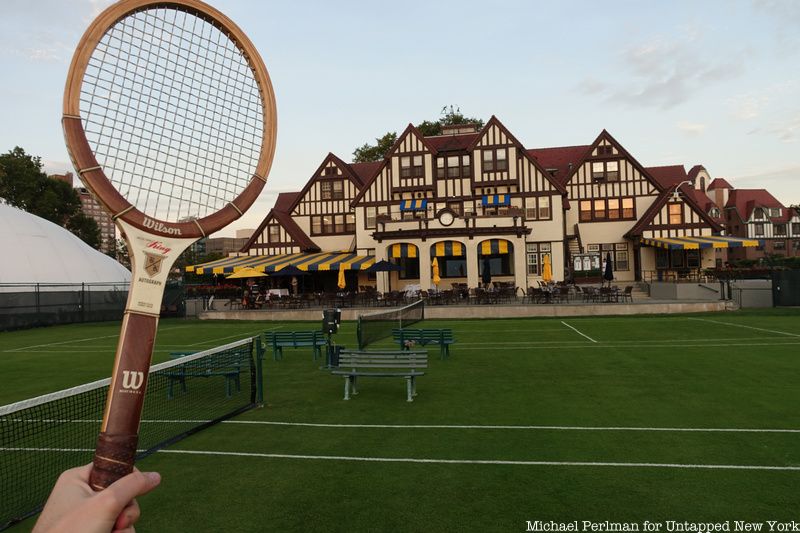
A Billie Jean King autographed racquet at the West Side Tennis Club
The venue also became a concert stadium for the likes of The Beatles, Frank Sinatra and Bob Dylan, and eventually the popularity of the U.S. Open outgrew the size of the stadium. In 1978, the United States Tennis Association moved the U.S. Open to USTA Billie Jean King National Tennis Center, three miles north of Forest Hills stadium, in Flushing Meadows-Corona Park. The move was opposed by some players as well as the West Side Tennis Club. “I think there was a sense of sadness among a lot of the long-time spectators who were wedded to being at Forest Hills where they’ve seen the tournament play going back to the 20s,” said Steve Flink, a tennis historian, during a CNN interview.
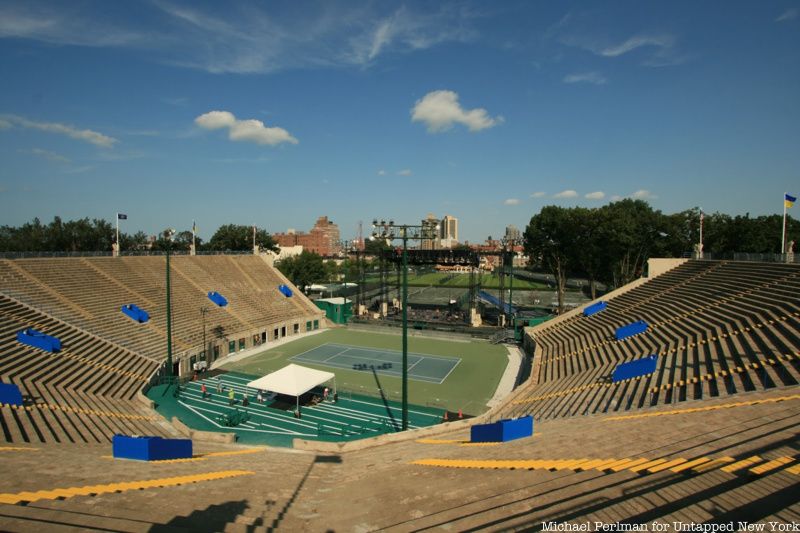 Forest Hills Stadium in 2013, setting up for a concert
Forest Hills Stadium in 2013, setting up for a concert
Before relocating to the new location, the last U.S Open at The West Side Tennis Club and the Forest Hills Stadium in 1977 was a bang, literally. A spectator was said to be shot in the leg not long after the match started, against the backdrop of bomb threats, protests and riots in the city during the tournament. It was also an important moment for transgender rights as Renée Richards, who underwent sex-change surgery in 1975, was allowed to compete as woman against her female opponents, despite eventually losing to Virginia Wade. The ‘77 Open was not only the last time clay court was used, but it also marked the debut of “spaghetti racket,” unique structure gave players advantages by making the balls move in unpredictable directions. It allowed Michael Fishbach, who built his own spaghetti racket with his brother, to beat the former U.S. Open champion Stan Smith. The racket was banned soon after.

Forest Hills Stadium in 2011
After the U.S. Open departed, Forest Hills Stadium dilapidated through the decades, and its legacy was slowly decaying in the midst of the ruins. In 1998, officials at West Side Tennis Club considered tearing down the stadium, as it was becoming a financial strain on the club members. The club at the time has been in a deficit for years and did not have the revenue to restore the stadium to its past glory. 
Twelve years later, club officials again floated the idea of selling the stadium, this time for $9 million to a developer who will demolish the stadium and use the land to build condominiums.
“As a Forest Hills resident and a fan of tennis and music, I felt very much disheartened,” Perlman said, wearing his Forest Hills Stadium T-shirt in an interview with Untapped New York recently.After a divisive vote amongst the club members, the proposal was voted down. Perlman, along with other community residents and club members, wrote letters to New York City’s Landmark Preservation Commission, but LPC officials refused to grant landmark status to the stadium due to its extensive deterioration. However, Perlman’s efforts and preservation initiatives received media attention as well as those interested in landmark preservation. In 2011, Perlman gave a tour to Untapped New York writers of Forest Hills as part of the effort to save the stadium. He also published numerous articles on this website about the history of the stadium from 2011 to 2013.
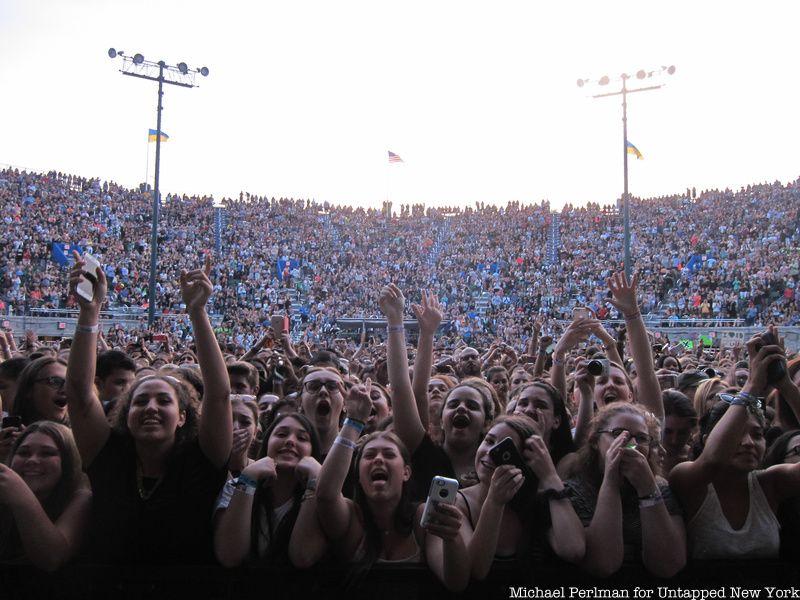
The crowd at an Ed Sheeran concert in Forest Hills Stadium
Fortunately by 2013, the stadium underwent a structural overhaul, and concert promotion company Madison House signed on to revive the stadium by hosting concerts and events, turning the former U.S. Open Tennis stadium into a venue for music artists. Perlman won the Historic Districts Council Grassroots Preservation Award for New York City in 2014 to honor his role in rescuing Forest Hills Stadium. among a few other preservation success stories in the area.

Sheryl Crow on stage at Forest Hills Stadium
Today, the Forest Hills Stadium remains a popular destination for concert enthusiasts. Mumford & Sons headlined the inaugural concert at the newly revived Forest Hills Stadium, and national and international acts like John Mellencamp, Tom Petty, Paul Simon, Ed Sheeran, Sheryl Crow, The Chainsmokers, The Chemical Brothers, Chance the Rapper, Belle & Sebastian, Arctic Monkeys, Van Morrison, The National, Santana and many more have graced the stage.
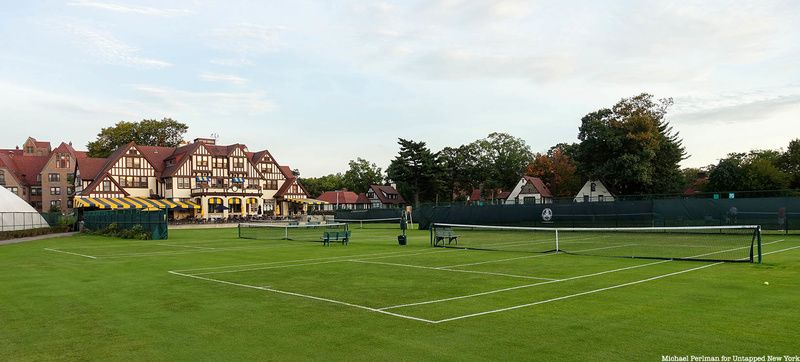
In the background of the Forest Hills Stadium, the West Side Tennis Club and its green grass lawn courts continue to be the place for its members to dine, drink, swim, and most importantly, play tennis. The West Side Tennis Club has 38 courts across four surfaces (clay, Har-Tru, grass, and hard courts), along with an Olympic-size swimming pool. Regular events honor tennis greats, like a 2018 Heritage Day attended by the brother of Arthur Ashe and Virgina Wade.
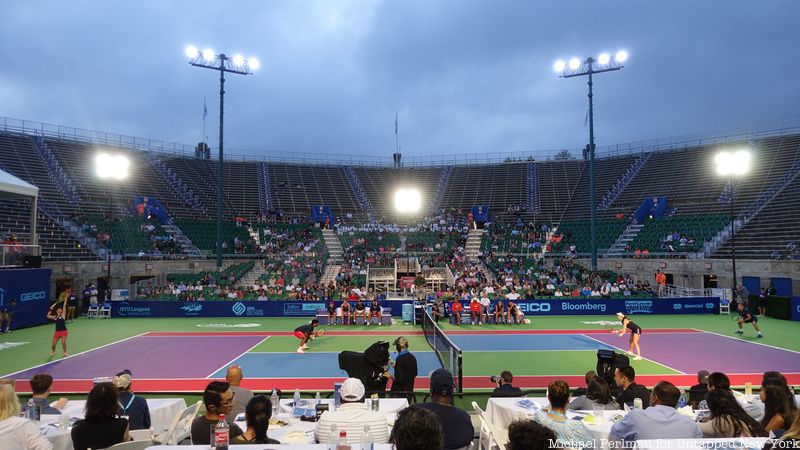
2016 Mylan World TeamTennis Tournament
The Forest Hills Stadium also welcomed back professional tennis in 2016 with the Mylan World Team Tennis competition. The 2020 concert season of the stadium, planned to welcome the Lumineers, Wilco, Bright Eyes and other bands, was cancelled. Like the rest of the world, the West Side Tennis Club and the Forest Hills Stadium are looking to 2021 and beyond.
Next, join us for an upcoming tour of the Remnants of the World’s Fair in Flushing Meadows-Corona Park, where you can also learn about U.S. Open history! All of our in-person tours have small groups, state-of-the-art radio ear pieces for safe social distancing, and more health & safety measures.
Subscribe to our newsletter